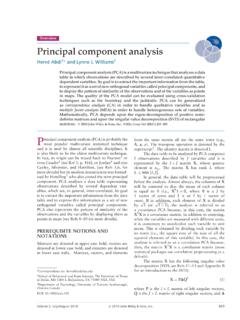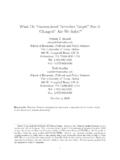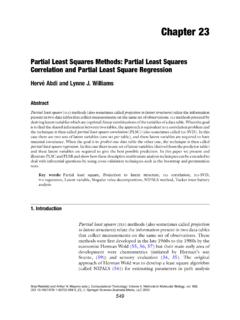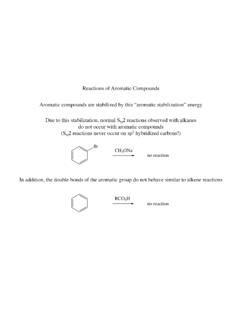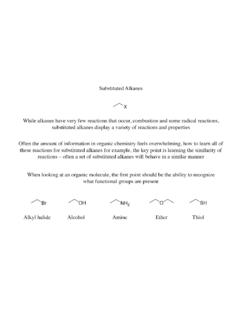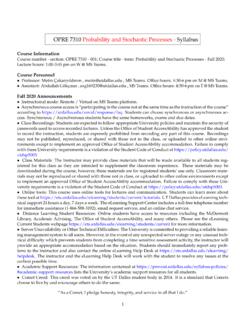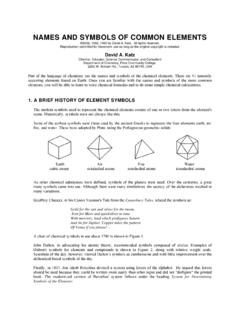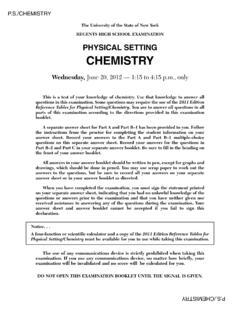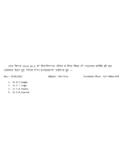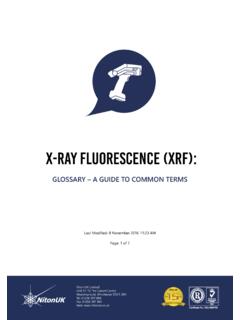Transcription of 1. ATOMIC STRUCTURE FUNDAMENTALS
1 BASIC CONCEPTSMost of this material is a review of general chemistry . You might find it helpful to keep a general chemistrytextbook available for reference purposes throughout the organic chemistry following diagram summarizes the basic facts of the STRUCTURE of the nucleus is the center of mass (A), butdoes not significantly contribute to is made up of:PROTONS: Mass = 1 amu, charge = +1 NEUTRONS: Mass = 1 amu, charge = 0 ELECTRONSThe electronic cloud determines the size, orvolume, of the atom, but does not significantlycontribute to massELECTRONS: Mass =.
2 0005 amu, charge = -1 Electrons are found outside the nucleusThey occupy orbitalsThey are the units of negative chargeThey determine the ATOMIC number (Z)The ATOMIC number determines the atom s identityElectronic cloudNucleusA simplified view of the hydrogenatom, which consists of only oneelectron outside the nucleus. Thenucleus contains only one protonand no neutrons. All other elementscontain neutrons in their ATOMIC STRUCTURE FUNDAMENTALSLEARNING OBJECTIVESTo review the basics concepts of ATOMIC STRUCTURE that have direct relevance to the fundamental conceptsof organic chemistry .
3 This material is essential to the understanding of organic molecular STRUCTURE and,later on, reaction FOUR QUANTUM NUMBERSThe quantum numbers are parameters that describe the distribution of electrons in the atom, and thereforeits fundamental nature. They are:1. PRINCIPAL QUANTUM NUMBER (n) - Represents the main energy level, or shell, occupied by anelectron. It is always a positive integer, that is n = 1, 2, 3 ..2. SECONDARY QUANTUM NUMBER (l ) - Represents the energy sublevel, or type of orbital, occupiedby the electron. The value of l depends on the value of n such that l = 0, 1.
4 N-1. This number is sometimesalso called azimuthal, or MAGNETIC QUANTUM NUMBER (ml ) - Represents the number of possible orientations in 3-D spacefor each type of orbital. Since the type of orbital is determined by l, the value of ml ranges between -l and+l such that ml = -l, ..0, ..+ SPIN QUANTUM NUMBER (mS ) - Represents the two possible orientations that an electron can havein the presence of a magnetic field, or in relation to another electron occupying the same orbital. Onlytwo electrons can occupy the same orbital, and they must have opposite spins.
5 When this happens, theelectrons are said to be paired. The allowed values for the spin quantum number ms are +1/2 and -1 in the periodic table are indicated by SYMBOLS. To the left of the symbol we find the atomicmass (A) at the upper corner, and the ATOMIC number (Z) at the lower :H11C126Na2311 SymbolAZElectron trade constitutes the currency of chemical reactions. The number of electrons in a neutral atom(that is, the ATOMIC number) gives the element its unique identity. No two different elements can havethe same ATOMIC number. The periodic table is arranged by order of increasing ATOMIC number, which isalways an contrast to the ATOMIC number, different forms of the same element can have different masses.
6 Theyare called isotopes. The following are representations for some of the isotopes of hydrogen and hydrogendeuteriumC126regular carbon, or C-12C136carbon-13, or C-13 The ATOMIC mass reported in the periodic table for any given element is actually a weighted average ofthe masses of its isotopes as found in nature. Thus the mass of carbon is reported as rather because it contains the relative contributions of both isotopes. The natural abundance of carbon-12 is nearly 100%, whereas that of carbon-13 is only about 1%. The reported mass is slightly greater because of the small contribution of carbon-13.
7 Therefore the mass number, as found in periodictables, does not have to be an integer like the ATOMIC to Heisenberg s uncertainty principle, it is impossible to know the electron s velocity and itsposition simultaneously. The exact position of the electron at any given time cannot be known. Therefore,it is impossible to obtain a photographic picture of the atom like we could of a busy street. Electrons aremore like fast-moving mosquitoes in a swarm that cannot be photographed without appearing uncertainty about their position persists even in the photograph.
8 An alternative picture of the swarmcan be obtained by describing the area where the mosquitoes tend to be concentrated and the factors thatdetermine their preference for certain locations, and that s the best we can quantum numbers provide us with a picture of the electronic arrangement in the atom relative to thenucleus. This arrangement is not given in terms of exact positions, like the photograph of a street, butrather in terms of probability distributions and potential energy levels, much like the mosquito potential energy levels are described by the main quantum number n and by the secondary quantumnumber l.
9 The probability distributions are given by the secondary quantum number l and by the magneticquantum number now outdated solar system model of the atom allows us to visualize the meaning of the potentialenergy levels. The main energy levels, also called shells, are given by the main quantum number n.+nucleusn = 1n = 2n = 3n = 4 The potential energyincreases as the distancefrom the nucleus increasesTHE RELATIONSHIP BETWEEN POTENTIAL ENERGY AND STABILITY IS INVERSEAs the potential energy of a system increases, the system s stability is more easily disrupted.
10 As an exampleconsider the objects on the earth. Objects that are positioned at ground level have lower potential energythan objects placed at high altitudes. The object that s placed at high altitude, be it a plane or a rock atthe top of a mountain, has a higher potential to fall (lower stability) than the object that s placed atground level. Systems tend towards lower levels of potential energy, thus the tendency of the plane or therock to fall. Conversely, an object placed in a hole on the ground does not have a tendency to climb out because its potential energy is even lower than the object placed at ground level.
